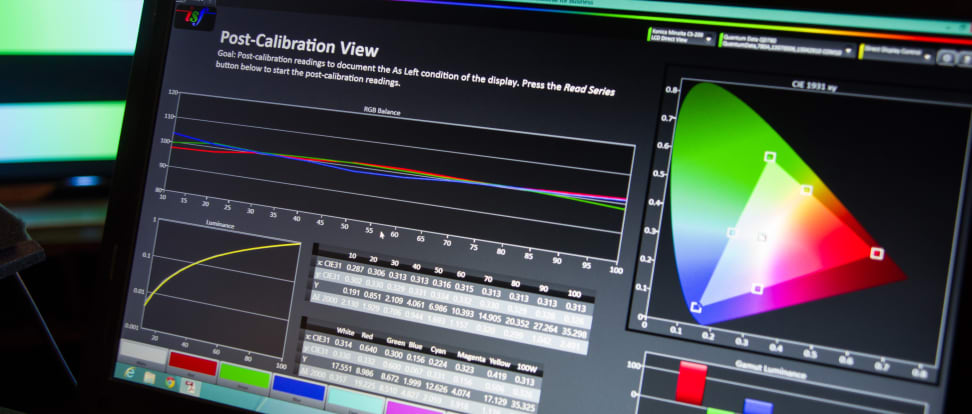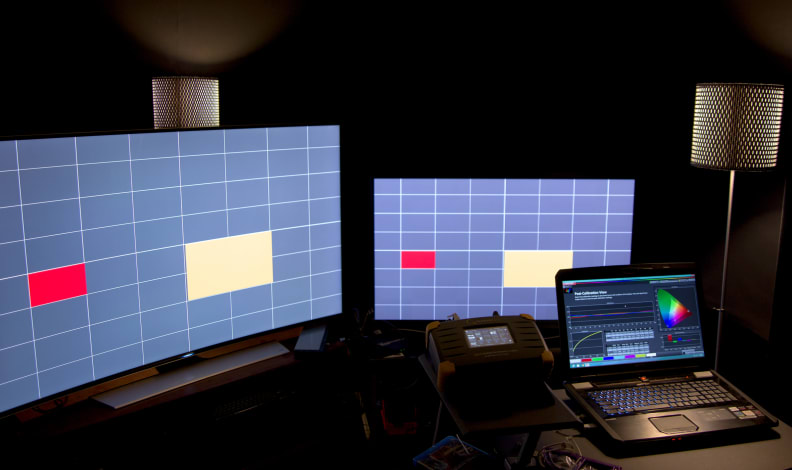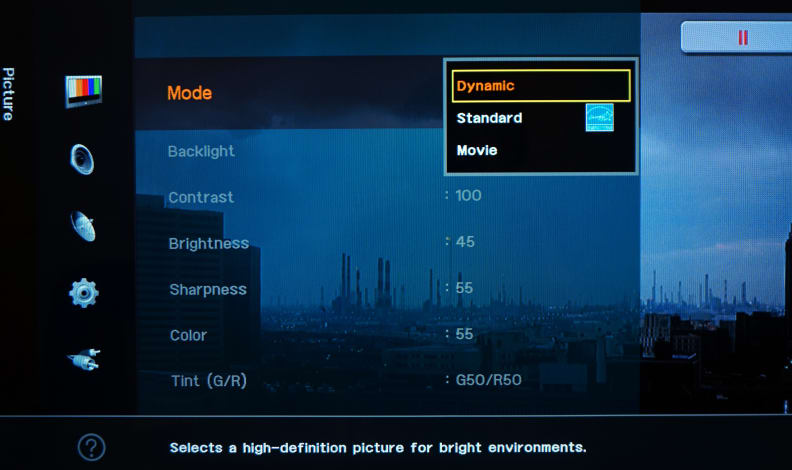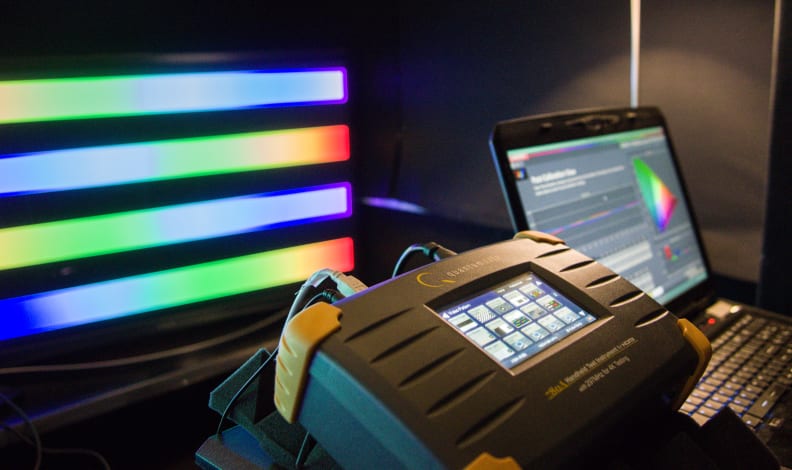What Is TV Calibration and Why Do I Need It?
No matter how much you paid for your TV, it can look better.
 Credit:
Reviewed.com / Lee Neikirk
Credit:
Reviewed.com / Lee Neikirk
Products are chosen independently by our editors. Purchases made through our links may earn us a commission.
When you go to the movies, you want to kick back and focus on the action. But if you settle into a matinee of The Avengers and the Incredible Hulk is yellow instead of green, you'll probably want to ask for a refund.
Fortunately, that's not a serious concern. The Hulk will be roughly the same shade of green no matter where you go, almost anywhere in the world, because movie theater projectors are calibrated to meet international standards of color and dynamics.
And guess what? You can do exactly the same thing with your TV at home. A professional calibrator's job is to ensure that the movie you watch at home looks exactly like it would in the theater. Ideally, a skilled calibrator can also tune the TV to the specifics of your viewing environment, maximizing visibility, clarity, and comfort regardless of the lighting or configuration of your space.
But whether you need to pay for a professional calibration depends on a few key factors, including price, your viewing environment, and how much tinkering you're willing to do on your own.
{{brightcove '3714551623001'}}
The Basics
Calibrating a TV simply means setting it to match a set of established standards. While the specifics of the standards can vary depending on what kind of TV or monitor you have, the core concepts and goals are always the same. In order of priority, a calibrator should:
Maximize dynamic range (contrast ratio) without destroying picture information
Tweak white balance (the color temperature of the whites) so that it matches a specific shade
Tune the colors so that they match a specific standard of performance
Ensure the use of proper bit-mapping (pixel mapping) for optimal resolution
These processes are rooted in some pretty complicated visual theory and color science, but if you break it down you're really just adjusting your set so that it's better attuned to how the human eye works.
The standards that dictate proper white balance and color presentation are pure data, however. For example, white balance (per international standards) should adhere to a CIE 1931 color gamut coordinate of x = 0.313, y = 0.329 with a correlated color temperature (CCT) of 6500K.
Sounds pretty complicated, right? Well, that's exactly why professional calibrators exist.
Why is TV calibration necessary?
Between roughly 1931 and 1990, modern calibration standards were elected and finalized by content creators, movie studios, color scientists, and cinematographers. The goal? To ensure that content looked the same around the world.
The only hitch? Due to the progressive nature of technological improvement, this existing standard also means that HDTVs need to be backwards-compatible with content created for analog tube TVs (CRTs).
By matching your TV to these standards, you can ensure that you're seeing content exactly as the creator intended—regardless of where (or when) it comes from. After a proper calibration, your TV should be operating within the same parameters as a Hollywood studio (or "reference") monitor. Pretty cool, right? And a precise picture isn't the only upside. Other benefits include a potentially longer overall lifespan for the TV, reduced eye strain, and lower energy consumption.

Calibration ensures that your TV operates within the same parameters used by Hollywood studios.
At this point, you might be wondering why your TV doesn't come out of the box already meeting the international standards. It's a very sensible thing to ask, in our opinion.
In part, it has to do with marketing. A calibrated TV is still capable of a bright, stunning picture, but a proper calibration is meant to bring out subtlety and nuance. Subtlety and nuance don't sell on the floor of a big box retailer, so most TVs are tuned to look extra flashy right out of the box to compete with all the other extra flashy TVs they're competing against.
There's also a degree of accuracy required in a proper calibration that would be financially impractical at a mass-produced factory level. Finally, just like musical instruments tend to slip out of tune over time, so do TVs—regardless of how expensive they are. Even if your TV arrived pre-calibrated, it would need a tune-up after a few months, meaning there's little reason to spend time and resources calibrating it at the factory.
Can't I just do it myself?
While a full-fledged calibration requires professional help (or at least professional tools), there's plenty that the average viewer can do to improve their picture.
Almost every modern TV includes a variety of picture modes. Understanding what each mode is designed to do is a great place to start.
{{amazon name="Spears & Munsil HD Benchmark and Calibration Disc 2nd Edition", asin="B00CKWI13O", align="right"}} * Vivid (or Dynamic) modes are what you'll see on a display TV at Best Buy or WalMart. They're designed for retailers, employing maximum backlight, excessive sharpening, and blue-skewed white balance. They might look great under the bright fluorescent lights of a show floor, but leaving your TV in one of these "torch" modes can shorten its life, tire your eyes, and destroy detail in the picture.
Standard mode tends to heavily throttle light output and dynamic range in order to meet Energy Star requirements for electricity consumption. Manufacturers are required to include this picture mode in order to market a TV, but that doesn't mean you have to use it. Standard is a better choice than Vivid or Dynamic, but it's not the best.
Modes called Movie, Cinema, Calibrated, or anything with "ISF" or "THX" in the title are your best bet for an accurate picture. They're generally as close as you can get to international standards without a proper calibration. In addition to tweaking color, contrast, and other technical details, they shut off unnecessary software enhancements while simultaneously unlocking and enabling the advanced picture controls a calibrator would need to tune the TV to perfection.

Switching to a mode like Movie or Cinema is a great way to make a quick, easy improvement to your viewing experience, but it may take a little while to adjust if you're used to a very bright picture. You know how hard it is to see when you head inside after being out in the sun? Same principle here.
If you want to take a bigger step toward a true calibration, you can begin by picking up a DVD or Blu-ray like Disney: WOW ($18 on Amazon), Spears & Munsil HD benchmark ($29 on Amazon), or the ISF's Calibration Wizard ($10 on Amazon). These calibration discs are a great way to get your TV in the right ballpark for not much money.
They'll take you through the basics of calibration, but won't get you into the weeds of tuning color or grayscale elements to the proper standards. For that, you need professional help.
When to hire a professional
Choosing the right picture mode and carefully following along with a calibration disc are good places to start, but there are lots of good reasons to pay for an in-home calibration.
For one, while most calibration discs will help you with the basic settings for brightness, contrast, and gamma, they don't (and can't) take into account the specifics of your viewing environment. And there are some aspects of calibration that simply must be done with a meter and a signal generator rather than by eye.
For this reason, TV and A/V systems experts stress the importance of individual calibration sessions tailored to specific viewer preferences, such as viewing distance and lighting.
For example, if a room has tons of windows or overhead lights, the calibration process can (and should be) very different from a calibration for a dark home theater environment.
A professional calibrator equipped with color/luminance meters, a signal generator, and calibration software will be able to fine-tune a TV's performance well beyond what the average viewer can do on their own. A trained professional will also understand the eccentricities of your specific device chain better much more quickly than if you attempted the process yourself.
Deciding whether you should hire a calibrator depends on a couple of important factors:
First, how expensive was your TV? A full calibration can run between $300 and $400, so it may not be worth it if the calibration costs more than the TV itself. Cheaper TVs may even lack the advanced controls (like multi-point grayscale control or a Color Management System) that a professional calibrator needs to perform a proper fine-tune.
Second, how much control do you have over lighting in your space? While it's possible to calibrate a TV for optimal performance in a brightly lit room, the subtler details that professional calibration can bring out may not even be visible if the TV brightness has to be jacked up to compete with ambient light.
Here's the takeaway: It makes the most sense to hire a professional calibrator if you have an expensive, high-quality TV that's in a dedicated viewing space like a home theater, where lighting is tightly controlled.

A professional calibrator can squeeze the most out of your TV, so you'll want a capable set in a dedicated viewing space.
It's also worth hiring a calibrator if your viewing setup is unusually complex. While an in-room surround sound speaker setup often goes hand-in-hand with a high-end TV and dedicated viewing space, there are definitely outliers.
The longer your "system chain" (A/V receiver, to game console, to disc player, etc.), the more likely it is that simply switching picture modes and using a calibration disc aren't going to get the job done. Blu-ray players and other signal sources often have their own picture controls, and a professional calibrator can create a single setup that works for your cable, disc media, and video game sources simultaneously.
The Breakdown
If you want make the jump from casual TV watching to a real theater-at-home experience, there's no substitute for a professional calibration. It's the best way to get the most value and lifespan from your TV, regardless of how expensive it was. And it's never too late for a tune-up.
Finding a calibrator may seem daunting, but there are a few easy ways to do it.
For starters, you can search databases of certified ISF and THX calibrators for service in your area and get in touch with one of the experts listed there. Another great option is to hop over to AVS Forum, a web community full of passionate video- and audiophiles. AVS hosts a regularly updated thread to help users find ISF Calibrators, and there's enough knowledge and discussion of specific TV models that it's a great resource even if you're looking to go the DIY route.
If your system is particularly complex, don't expect a calibration to come cheap. While Best Buy offers a TV Calibration Service that runs about $250, users with more complex setups (such as rear-projection TVs, or newer OLED models) may find quotes edging into the four-digit range.
It's understandable if you're on the fence about paying for a full calibration. Before you make a call, do yourself a favor and try out your TV's Movie or Cinema mode for a few hours. Unless your TV is in an extremely bright space, you'll likely begin to appreciate the increased detail and nuance these presets deliver. If you like what you see, you may then want to pursue one of the many available calibration discs so you can take things one step further.
Finally, remember this: Even if your TV isn't perfectly calibrated, all that matters is whether you like the way it looks.
